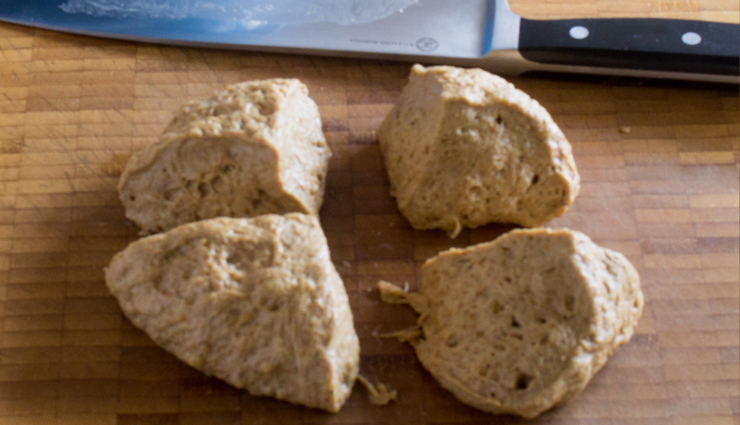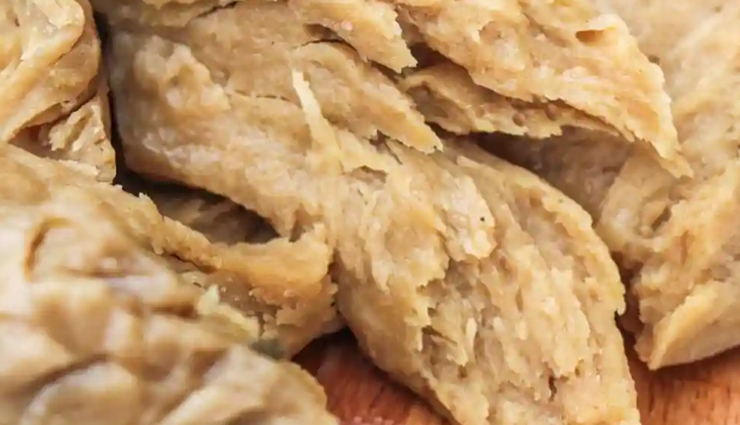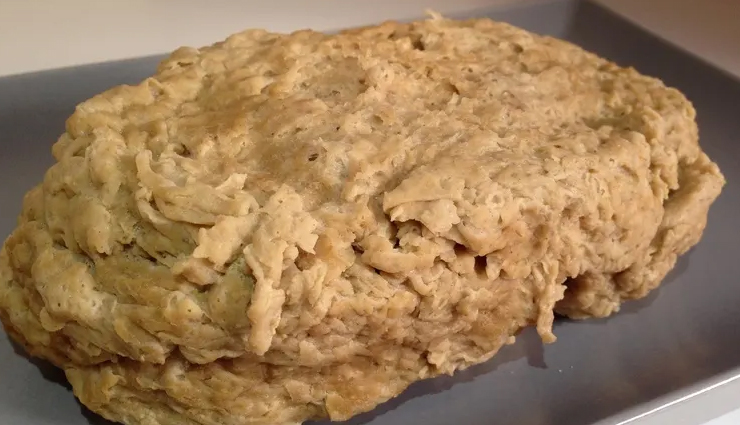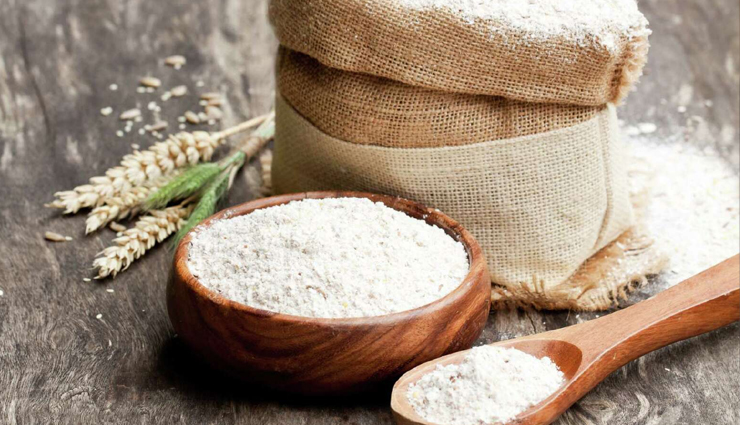- Home›
- Healthy Living›
- Seitan Nutrition: Benefits, Side Effects, And How To Make It
Seitan Nutrition: Benefits, Side Effects, And How To Make It
By: Priyanka Maheshwari Sun, 23 July 2023 1:44:14

Seitan, also known as wheat gluten or wheat meat, is a popular plant-based protein source used as a meat substitute in vegetarian and vegan diets. It is made from gluten, the protein found in wheat, which is extracted from wheat flour and processed to create a dough-like texture. The name "seitan" is derived from the Japanese words "sei" (meaning "to be made") and "tan" (short for "tanpaku," meaning "protein").
The process of making seitan involves washing wheat flour dough with water to remove the starch. What remains is a sticky and elastic mass of gluten protein. This gluten mass is then kneaded and rinsed repeatedly to remove any remaining starch, leaving behind a concentrated gluten product.
Seitan has a chewy and meat-like texture, making it a popular substitute for meat in various dishes. It has a neutral flavor, which allows it to absorb the flavors of the seasonings and sauces it is cooked with. It can be seasoned, marinated, and cooked in a variety of ways, making it a versatile ingredient in vegetarian and vegan cooking.
Due to its high protein content, seitan is an excellent source of plant-based protein for those following meat-free diets. It is also low in fat and contains essential amino acids, making it a nutritious option for individuals seeking to increase their protein intake without consuming animal products.
Seitan is widely used in a variety of dishes, such as stir-fries, curries, stews, sandwiches, and more. It has become a popular choice among vegetarians, vegans, and individuals looking to reduce their meat consumption while still enjoying dishes with a meaty texture and flavor.

Seitan – Nutrition Facts
Seitan, also known as wheat gluten or wheat meat, is a nutritious plant-based protein source. Here are the approximate nutrition facts for 100 grams of seitan:
Calories: 370 kcal
Protein: 75 grams
Carbohydrates: 7 grams
Fiber: 0.4 grams
Fat: 1.9 grams
Saturated Fat: 0.4 grams
Monounsaturated Fat: 0.3 grams
Polyunsaturated Fat: 0.9 grams
Cholesterol: 0 milligrams
Vitamin B6: 0.4 milligrams (23% of the Daily Value)
Iron: 2.5 milligrams (14% of the Daily Value)
Calcium: 16 milligrams (2% of the Daily Value)
Magnesium: 36 milligrams (9% of the Daily Value)
Phosphorus: 67 milligrams (7% of the Daily Value)
Potassium: 120 milligrams (3% of the Daily Value)
Sodium: 500 milligrams (21% of the Daily Value)
Seitan stands out for its remarkable protein content, making it a superb choice for individuals looking to enhance their plant-based protein intake. Notably, seitan provides all nine essential amino acids, rendering it a complete and valuable protein source.
However, it is crucial to be aware that although seitan is low in fat, its sodium content can be relatively high, particularly when seasoned or cooked with certain sauces. Consequently, those who need to monitor their sodium intake should exercise caution and be mindful of the ingredients utilized in seitan preparations.

Is Seitan Healthy?
Seitan can be a valuable addition to a balanced diet, particularly for individuals embracing a vegetarian or vegan lifestyle or those aiming to reduce meat consumption. Its numerous health benefits stem from its high protein content and low fat content. Here are some reasons why seitan is considered a healthy dietary choice:
High Protein Content: Seitan is a rich source of protein, making it an excellent option for vegans, vegetarians, and individuals looking to boost their protein intake. Protein is essential for muscle repair, immune function, and overall growth and development.
Complete Protein Source: Seitan contains all nine essential amino acids, making it a complete protein source. Consuming a complete protein ensures that the body receives all the essential building blocks it needs for various bodily functions.
Low in Fat: Seitan is naturally low in fat, particularly saturated fat, making it a favorable choice for those aiming to reduce their fat intake and support heart health.
Cholesterol-Free: As a plant-based protein, seitan is cholesterol-free, which can be beneficial for heart health and reducing the risk of cardiovascular diseases.
Nutrient-Rich: Seitan contains essential minerals such as iron, calcium, magnesium, phosphorus, and potassium, which contribute to bone health, energy production, and various bodily functions.
Versatility: Seitan's neutral taste and meat-like texture make it a versatile ingredient in a wide range of dishes. It can be seasoned, marinated, and cooked in various ways, adapting to different culinary creations.
Sustainable Choice: Seitan production typically requires fewer natural resources compared to some animal-based protein sources, making it a more environmentally-friendly protein option.
Low in Carbohydrates: Seitan is relatively low in carbohydrates, making it suitable for individuals following low-carb or keto diets.

Side Effects Of Seitan
Gluten Sensitivity: Seitan is made from wheat gluten, which is a type of protein found in wheat. Individuals with gluten sensitivity or non-celiac gluten sensitivity may experience digestive issues, such as bloating, gas, diarrhea, or abdominal discomfort, after consuming seitan.
Celiac Disease: People with celiac disease, an autoimmune disorder triggered by gluten consumption, must strictly avoid seitan and all other gluten-containing foods. For individuals with celiac disease, consuming seitan can lead to severe intestinal damage and other health complications.
Allergic Reactions: Some people may be allergic to wheat gluten, and consuming seitan can trigger allergic reactions. Allergic symptoms may include itching, hives, swelling of the lips or throat, difficulty breathing, and anaphylaxis, which is a severe and potentially life-threatening reaction.
High Sodium Content: Depending on how it is prepared, seitan can be high in sodium. Individuals who need to monitor their sodium intake should be cautious when consuming seitan dishes that are seasoned with high-sodium sauces or seasonings.
Over consumption: As with any food, excessive consumption of seitan may lead to digestive discomfort or bloating in some individuals. It's essential to enjoy seitan in moderation as part of a well-balanced diet.
Nutritional Imbalance: Relying heavily on seitan as the sole protein source may lead to a lack of dietary diversity and potential nutrient deficiencies. It's crucial to incorporate a variety of protein sources and nutrient-rich foods in the diet.
Sensitivity to Other Ingredients: Some recipes for homemade seitan may include additional ingredients like nutritional yeast, soy sauce, or spices. Individuals with allergies or sensitivities to these ingredients should be cautious and modify recipes as needed.

How To Make Your Own Seitan
Ingredients
1 cup vital wheat gluten
1/4 cup nutritional yeast (optional, for added flavor)
1 teaspoon garlic powder
1 teaspoon onion powder
1/2 teaspoon paprika (smoked paprika can add a smoky flavor)
1 cup vegetable broth or water
2 tablespoons soy sauce or tamari (for a gluten-free option)
1 tablespoon olive oil (optional, for added moisture)
Method
- In a mixing bowl, combine the vital wheat gluten, nutritional yeast, garlic powder, onion powder, and paprika. Stir the dry ingredients together until well mixed.
- In a separate bowl, mix the vegetable broth or water with the soy sauce (or tamari) and olive oil (if using).
- Slowly add the wet ingredients to the dry ingredients, stirring as you pour. Mix well to form a dough.
- Knead the dough for about 3-5 minutes until it becomes elastic and firm.
- Let the dough rest for a few minutes to relax the gluten.
- Shape the dough into your desired form, such as cutlets, strips, or small chunks.
- In a large pot, bring water or vegetable broth to a simmer. The liquid should be enough to cover the seitan pieces.
- Carefully place the seitan pieces into the simmering liquid.
- Cover the pot with a lid and let the seitan cook at a gentle simmer for about 45 minutes to 1 hour. The seitan will expand as it cooks.
- Once the seitan is cooked, remove it from the liquid and let it cool.
- You can use the seitan immediately in your favorite recipes or store it in the refrigerator for up to a week. Seitan can also be frozen for later use.
Note: You can customize the flavor of your seitan by adding different herbs, spices, or sauces to the cooking liquid. Experiment with various seasonings to create a seitan that suits your taste preferences.





